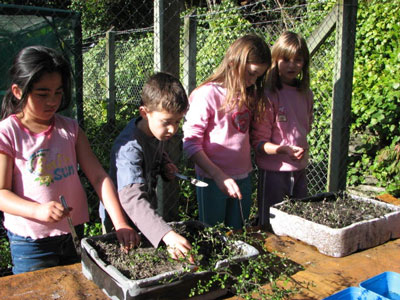 Moturoa Primary School in New Plymouth has made gardening part of its curriculum.
Moturoa Primary School in New Plymouth has made gardening part of its curriculum.
In 1994 the school re-introduced the annual planting of school gardens by the children, marking Arbor Day. Every year since, they have created and planted out a new garden.
Moturoa School was the first Trees for Survival school in Taranaki, opening its propagation unit in December 1996 with funding from Westgate Transport Ltd, Port Taranaki. New Plymouth Rotary West assembled the unit and supplied many man hours and additional funding.
Environmental Teacher Bill Clarkson works with groups of four children at a time from each classroom, ensuring that every pupil in the school is involved. The groups take turns, with nine groups spending 20 minutes once a week working intensively with Bill. They learn the full propagation process, involving skills of propagation from cuttings and seeds and working with the plants at all stages of development. They learn about maintaining the garden and ongoing planting, practise identification skills and learn to respect the importance of native plants in the environment. The end result is the satisfaction of planting these rare plants into their school gardens and back into the environment.
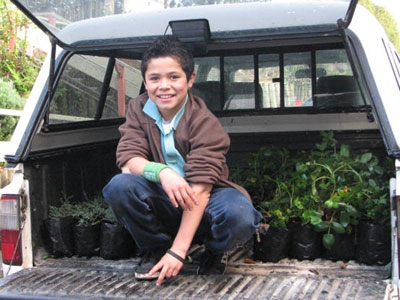 Initially Duncan and Davies donated seedlings but it wasn’t long before Moturoa School’s focus changed to growing local endangered plants.
Initially Duncan and Davies donated seedlings but it wasn’t long before Moturoa School’s focus changed to growing local endangered plants.
The Taranaki Regional Council awarded Moturoa School the Taranaki Regional Council Environmental Award in 1998. They were the first school in Taranaki to receive the award. They were honoured again in 2004.
In 1999 they focused on the Paritutu Korokio, an endangered local plant found in limited numbers on Mt Paritutu, one kilometre from their school. In 2001 they went on to establish the tradition of presenting one of these special plants as a farewell gift to year 6 students at the end of their Moturoa School career.
They have also been growing another coastal plant, Pimelea prostrata var urvilleana (Pinatoro), which is similarly endangered.
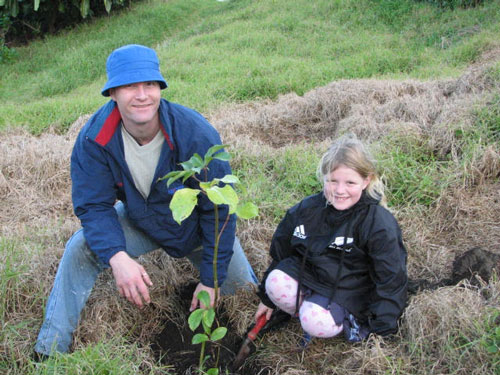 Moturoa School proudly supplied 100 plants, propagated during 2005, towards the New Plymouth District Council’s Herekawe Stream Project 2006.
Moturoa School proudly supplied 100 plants, propagated during 2005, towards the New Plymouth District Council’s Herekawe Stream Project 2006.
In 2006 they focused on a more threatened local plant, Scandia rosifolia var (New Zealand Angelica). The Taranaki variety has only one confirmed plant in the wild. DOC collected six seeds from this plant, which were given to the school. They took them and lovingly cared for them, raising healthy parent plants. The seeds collected from these second generation plants have now raised 600 seedlings in the Moturoa School propagation unit.
On 3 August 2007, 35 Scandia and 25 Primelea plants were supplied by the school, destined for two garden beds in the main street of Opunake.
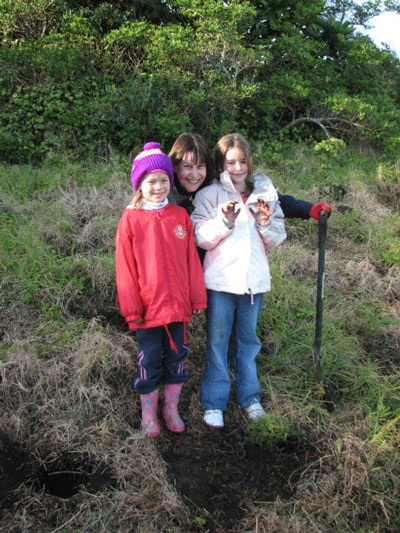 Bill is a very busy man around the school. From deputy principal in 1994 to temporary early retirement in 2001, he is now employed for five hours a week. He spends many more hours setting up teaching resources to integrate learning about plants and the environment into the classroom studies. Bill is passionate about teaching the children about endangered native plants in their local environment. One such programme is Adopt a Plant or Tree a term. The children intensively study a plant or tree in their classroom group. They study native plants growing in the school gardens or grounds. They learn identification skills, about environmental habitats and plant and animal relationships. These lessons promote special interest in local native plants and teach care and respect for the environment.
Bill is a very busy man around the school. From deputy principal in 1994 to temporary early retirement in 2001, he is now employed for five hours a week. He spends many more hours setting up teaching resources to integrate learning about plants and the environment into the classroom studies. Bill is passionate about teaching the children about endangered native plants in their local environment. One such programme is Adopt a Plant or Tree a term. The children intensively study a plant or tree in their classroom group. They study native plants growing in the school gardens or grounds. They learn identification skills, about environmental habitats and plant and animal relationships. These lessons promote special interest in local native plants and teach care and respect for the environment.
With the help of the children, extensive gardens containing many rare native plants have been planted within the school grounds. The beach garden is recycling at its best. A sandpit placed in a shady area did not draw the children. Bill Clarkson decided to utilise the space by introducing beach plants. The garden contains plants of the Taranaki Coast including Pingao (Golden Sand Tussock), Peperomia urvilleana, Scandia rosifolia (native Angelica), Pimelea prostrata (Pinatoro, host of the day-flying native moth, Notoreas “Taranaki”) and Runnunculus recens (Sand Buttercup) among others.
Bill has set up information and activity resources to promote the use of these gardens as outdoor classrooms.
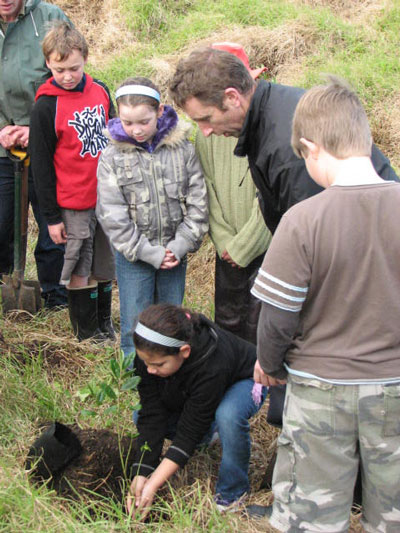 The school works closely with Nathan Hill – Department of Conservation, John Leslie – New Plymouth District Council, and Peter Heard – Taranaki Environment Centre.
The school works closely with Nathan Hill – Department of Conservation, John Leslie – New Plymouth District Council, and Peter Heard – Taranaki Environment Centre.
In 2002, teacher Mark Fisher went on a course where he heard about Enviroschools. He brought the idea back and the process began. Moturoa School was then officially recognised as an Enviroschool, the first in Taranaki. For those interested in the details of the Enviroschool curriculum, there is further information at the end of this article.
In 2004 the school started up an Envirogroup. The group consists of two children from every class in the school, who are elected, along with two teachers – including Alwyn MacLeod. This group stays in power for the school year. They meet on Thursday lunchtimes to talk about mini projects they can do such as composting or cleaning areas of their school from rubbish, and they discuss plans, new ideas and fundraising.
In 2006 they established the vegetable garden. Each classroom within the school has their own garden. “We have celery, in our garden. When these vegetables are ready to harvest we have decided to make vegetable soup, vegetable patties and quiche,” advises Alwyn MacLeod. “The garden is a wonderful learning environment for the children. They learn about maths with weights and measurements and they read the recipes, increasing their spelling and language skills.”
The current 2007 project is a Tree Hut. The whole school has been asked for their ideas and these have all been transferred on to a brainstorm map.
The project for 2008 is a Peace Garden. The children envisage natives, edible plants, seating, pathways and a water feature.
What can you do in your area?
Clean Up NZ Week is from 8-16 September. Do your bit to keep our environment clean and tidy. Contact your local council for events in your area.
There are many public plantings going on around the country. Contact your local council as they are always happy to have another spade and pair of hands to help. These are wonderful ways to get involved in your community and the children involved in caring for their environment through gardening.
Further information on Enviroschools
The Enviroschool curriculum has five themes:-
– Living Landscapes
– Ecological Buildings
– Healthy Water
– Precious Energy
– Zero Waste
The school agrees to incorporate the following principles into the school management practices and curriculum:-
Physical Surroundings
Ecological and participatory design of school surroundings will create:-
– A school environment in harmony with its place and people
– Healthy and environmentally friendly classrooms
– Places for recycling and composting
– A range of stimulating and special places for students
– The incorporation of local ecosystems and wildlife habitats
– The recognition and preservation of historical landmarks
Operational Practices
Sustainable conservation practices in the day-to-day running of the school will enable students and staff to:-
– Reduce waste and create ways to reuse and recycle it
– Save energy, water and all resources
– Choose environmentally friendly products
– Be more aware of nature
– Improve the quality and health of ALL forms of life
Organisational Principles
Participatory and democractic school management will support people to:-
– Communicate more with others
– Carry out self-auditing and monitoring
– Consider equity and diversity when making decisions
– Have a sense of belonging and ownership
– Create a peaceful, harmonious school community
A Living Curriculum
A living curriculum is dynamic, integrating the informal curriculum of all areas of school life with the formal curriculum. Creating a living curriculum will encourage teachers and students to:-
– Make use of all learning experiences, including play
– Draw on the combined wisdom of our multicultural community
– Create opportunities for student environmental action
– Involve education outside the classroom
– Promote critical questioning of resource use and lifestyle
– Promote reflection on personal values and behaviours
Environmental Education
– In The Environment – Sensory experiences of nature and Making a food garden.
– About the Environment – Studying nature, Viewing environmental videos, Mapping soil types and Sketching plants and animals.
– For the Environment – Buying unbleached paper, Composting for use in school gardens, Creating native habitats, Zero waste practices, Using small-scale technologies and Conserving water and energy.
Children’s Participation:-
– Taking responsibility and making decisions
– Planning their own curriculum
– Identifying their own issues
– Building their designs
– Getting involved
– Use of personal experiences
– Discussing issues with Board of Trustee members
– Incorporating children’s ideas into school planning
This article was published in Kids Friendly NZ September 2007 on-line edition
